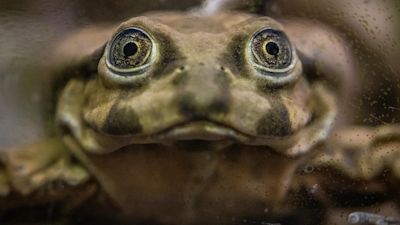Endangered 'scrotum frogs' to go on display at Chester Zoo for the first time

Endangered frogs from South America that have an unfortunate nickname have gone on display at Chester Zoo for the first time.
The 'scrotum frog' is the world's largest aquatic frog and can only be found in Lake Titicaca.
Experts are studying their behaviour to try to gather new insights as part of the latest conservation efforts for the species.
This is the first time that the rare species can be seen at the zoo.
Chester Zoo was the first in Europe to give a home to the species and has now established a European population by sending 130 other frogs to 13 other leading, progressive zoos around the continent to help prevent total extinction of the frog.
WHAT IS A 'SCROTUM FROG'?
The frogs have been given their peculiar nickname due to saggy folds of excessive skin that enables the frog to breathe.
It spends most of its time at the bottom of the lake, absorbing oxygen from the water with its skin.
Lake Titicaca frogs can grow up to 20 inches (50cm) long and weigh almost a kilogram and are completely aquatic with large flat heads.
Due to a lack of oxygen in their environment, their lungs are less than one-third of the size that would be expected for a frog of its size.
They breathe primarily through their skin which features many large folds. The folds essentially serve as gills. The species has the lowest reported metabolic rate of any frog
They are listed as endangered by the International Union for the Conservation of Nature (IUCN), with between 50% - 80% estimated as having been lost from Lake Titicaca in the last 20 years alone.